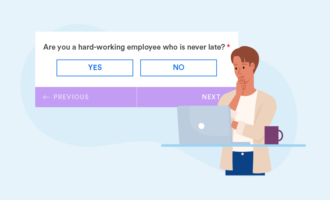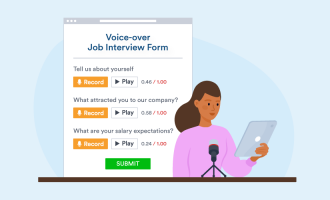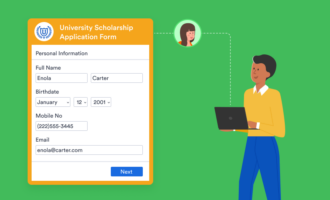In the digital age, data is the lifeblood of every organization. In fact, some experts claim it’s more valuable than oil. However, even if an organization has all the data in the world, it won’t matter if it’s not in a usable format. That’s where data entry comes in.
Data entry is the process of transforming raw data into organized, accessible, and actionable information. Manual data entry methods are notorious for being time-consuming and error- prone. Fortunately, new technology has made automated data entry not only possible, but also incredibly easy to set up. Read on to learn more about tools that will help ensure you get the most out of your data through automation.
The basics of automated data entry
Automated data entry is an advanced process for streamlining data extraction from a variety of sources and inputting it into databases — with zero or minimal manual data entry required by workers. This innovative approach makes it easy to capture, validate, and organize data from virtually any type of document, including PDFs, emails, online forms, images, and more. From there, the data entry solution can automatically categorize the information and convert it into structured data.
To do this, data entry automation solutions require collaboration between a variety of tools. For example, optical character recognition (OCR), a technology that’s been around for decades, allows systems to recognize and extract text from PDFs and image files and convert it into manipulatable data. Machine learning and AI can then recognize this text, automatically apply labels, or carry out other actions to convert it into usable data. All of this significantly reduces errors, enhances data accuracy, and drastically improves the overall efficiency of data management processes.
Manual vs automated data entry
Automated data entry offers significant benefits compared to manual data entry. Here are some of the most notable advantages:
- Increased efficiency: Automation relies on software, algorithms, and technology-driven processes to quickly and systematically capture and input data. It operates at a much higher speed than humans are capable of, significantly reducing the time required to process large volumes of information.
- Higher accuracy: In spite of the increased processing speed, automation systems significantly reduce errors with OCR and validation algorithms that ensure text is accurately read and converted. Machines can consistently process data without becoming fatigued or losing concentration, resulting in better accuracy.
- Greater scalability: Automated systems can easily scale to handle large volumes of data without any increase in labor, resources, or time. Unlike people, automated data entry solutions can process data nonstop, making them ideal for organizations with growing data needs.
- Better cost-effectiveness: Though initial software investment and setup costs can be more expensive than hiring new workers, automated data entry systems often prove more cost-effective in the long run due to their efficiency, reduced error rates, and scalability. Data entry automation allows organizations to quickly achieve ROI, whereas investing in manual data entry creates even more costs.
Automated data entry use cases
Automated data entry has abundant use cases in nearly every industry, department, and organization. Essentially, automating data entry can offer a more cost-effective and streamlined solution for any process that requires data collection. Here are some of the most common examples:
- Insurance: Automating data entry can help quickly and accurately process policy applications, claims, and underwriting documents. By automatically extracting and validating information from sources like medical records, accident reports, or customer submissions, users in the insurance industry can dramatically speed up claims processing, reduce errors, and enhance customer service.
- Contract management: In contract management, data entry can take over the tasks of inputting and tracking contract details, key dates, obligations, and more. This ensures contract managers consistently renew or terminate agreements on time. These capabilities reduce the risk of missed deadlines, contract disputes, and other time-consuming and costly issues that can occur in contract management.
- Banking: Financial institutions can use data entry solutions for document-heavy processes like customer onboarding, transaction processing, and compliance reporting, accelerating timelines for opening accounts and improving transaction accuracy.
- Real estate: Automatic data entry can be exceptionally beneficial for tasks like managing property listings, processing lease agreements, and collecting client information. It simplifies the process of updating property details, tracking lease terms, and maintaining client records, leading to more efficient property management and sales processes.
Powerful automated data entry with Jotform
There are a wide variety of automated data entry solutions on the market, some more affordable and easier to implement than others. Jotform, a leading online form builder, offers a number of capabilities that streamline data entry.
It’s easy to get started. First, create a form to collect the type of data you need. Jotform has a library of over 10,000 customizable form templates, including PDF templates. The platform also features a robust library of table templates to customize your form response databases.
Jotform offers a number of integrations with third-party automation solutions like Zapier, Integromat, and Microsoft Power Automate to further streamline workflows. Just choose the platform that suits your needs and connect it through your Jotform account.
Automated data entry can revolutionize how organizations collect and manage their data, transforming it into a streamlined, cost-effective, and scalable process. As data volume continues to grow in every industry, data-entry automation could soon be a requirement for organizations looking to succeed. It’s important to adopt it early to gain a competitive advantage.
Photo by Mikael Blomkvist































Send Comment: